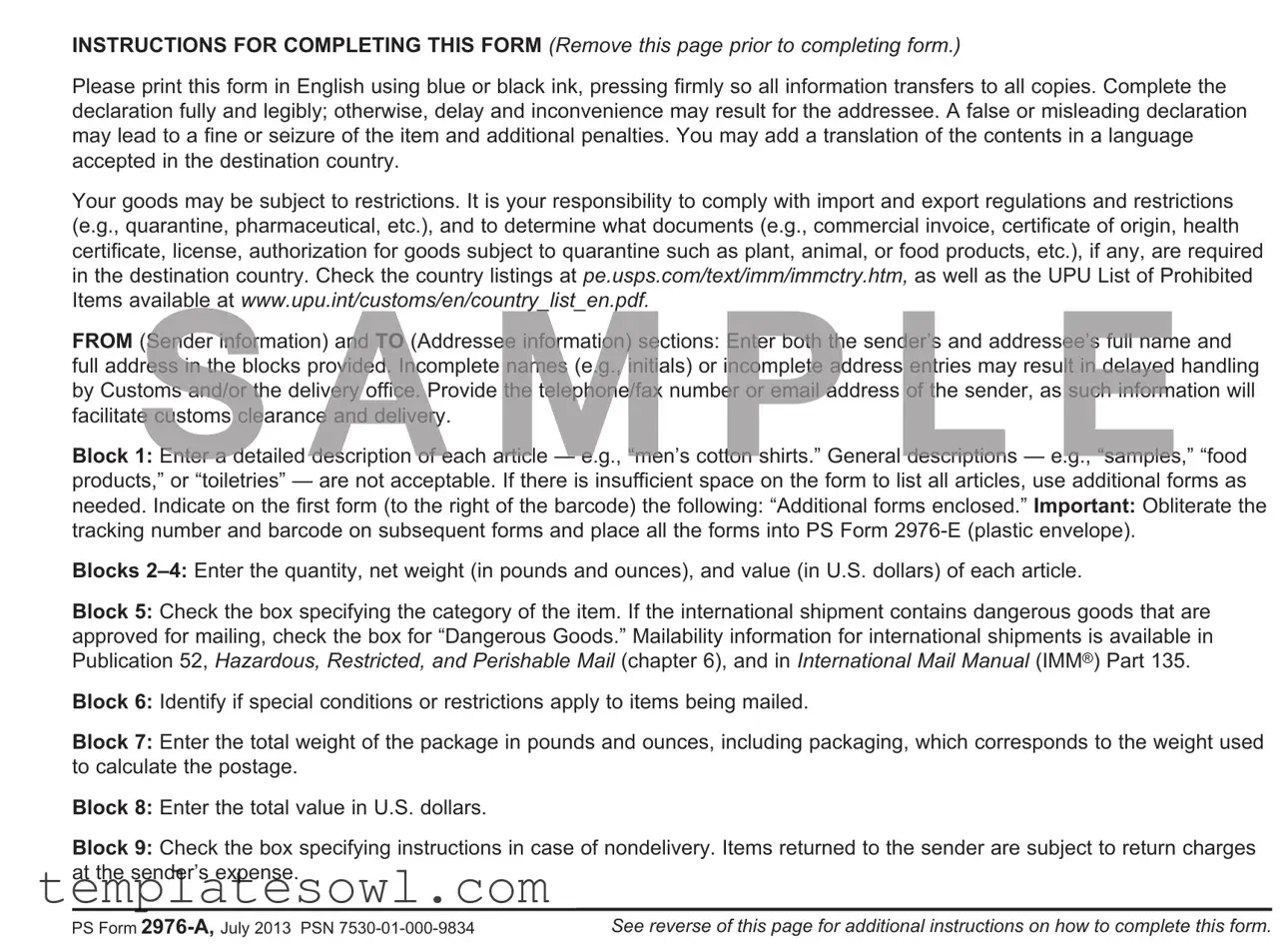INSTRUCTIONS FOR COMPLETING THIS FORM (Remove this page prior to completing form.)
Please print this form in English using blue or black ink, pressing firmly so all information transfers to all copies. Complete the declaration fully and legibly; otherwise, delay and inconvenience may result for the addressee. A false or misleading declaration may lead to a fine or seizure of the item and additional penalties. You may add a translation of the contents in a language accepted in the destination country.
Your goods may be subject to restrictions. It is your responsibility to comply with import and export regulations and restrictions (e.g., quarantine, pharmaceutical, etc.), and to determine what documents (e.g., commercial invoice, certificate of origin, health certificate, license, authorization for goods subject to quarantine such as plant, animal, or food products, etc.), if any, are required in the destinationScountry.ACheck the country Mlistings at pe.usps.com/text/imm/immctryP.htm,Las well as the UPUEList of Prohibited Items available at www.upu.int/customs/en/country list en.pdf.
FROM ( ender information) and TO ( ddressee information) sections: Enter both the sender’s and addressee’s full name and full address in the blocks provided. Incomplete names (e.g., initials) or incomplete address entries may result in delayed handling by Customs and/or the delivery office. Provide the telephone/fax number or email address of the sender, as such information will facilitate customs clearance and delivery.
Block 1: Enter a detailed description of each article — e.g., “men’s cotton shirts.” General descriptions — e.g., “samples,” “food products,” or “toiletries” — are not acceptable. If there is insufficient space on the form to list all articles, use additional forms as needed. Indicate on the first form (to the right of the barcode) the following: “Additional forms enclosed.” Important: Obliterate the tracking number and barcode on subsequent forms and place all the forms into PS Form 2976-E (plastic envelope).
Blocks 2–4: Enter the quantity, net weight (in pounds and ounces), and value (in U.S. dollars) of each article.
Block 5: Check the box specifying the category of the item. If the international shipment contains dangerous goods that are approved for mailing, check the box for “Dangerous Goods.” Mailability information for international shipments is available in Publication 52, Hazardous, Restricted, and Perishable Mail (chapter 6), and in International Mail Manual (IMM®) Part 135.
Block 6: Identify if special conditions or restrictions apply to items being mailed.
Block 7: Enter the total weight of the package in pounds and ounces, including packaging, which corresponds to the weight used to calculate the postage.
Block 8: Enter the total value in U.S. dollars.
Block 9: Check the box specifying instructions in case of nondelivery. Items returned to the sender are subject to return charges at the sender’s expense.
PS Form 2976-A, July 2013 PSN 7530-01-000-9834 |
See reverse of this page for additional instructions on how to complete this form. |

Block 10: Except for shipments to APO/FPO/DPO addresses, enter an Automated Export System (AES) Internal Transaction Number (ITN), AES Exemption, or if applicable, an AES Downtime Citation. This standard may also apply when mailing items to, from, and between U.S. territories, possessions, and Freely Associated States — see DMM 608.2.5. One of these codes must appear in the “AES/ITN/Exemption” block before the Postal Service will accept a package for mailing. In general, mailpieces containing any type of goods (per Schedule B Export Codes at www.census.gov/foreign-trade/schedules/b) valued at more than $2,500, or requiring an export license under U.S. law, must have an ITN issued by the U.S. Census Bureau or an AES Downtime Citation, subject to certain exceptions. Mailpieces that are exempt from filing must have an AES Exemption. Regardless of exemptions, all mailpieces must have an ITN or AES Downtime Citation if they are destined to certain countries on which the U.S. has a comprehensive embargo. To obtain an ITN and file electronically through the Census Bureau’s AES, or for additional information, please visit www.census.gov/foreign-trade/aes or call 800-549-0595. For additional information, refer to U.S. Postal ServiceS® Publication 699, ASpecial RequirementsMfor Shipping InternationallyP, and to IMM PartL520. E
AES Exemption. In order to comply with U.S. Census Bureau’s Foreign Trade Regulations, indicate “NOE I § 30.37(a),” if applicable. “NOEEI § 30.37(a)” may be used when the value of each class of goods is $2,500 or less, if an export license is not required. Do NOT use this ES Exemption for items sent to Cuba, Iran, North Korea, Sudan, or Syria. Further information can be found in IMM Parts 526 and 527.
Block 11: Check the box if the contents are subject to quarantine restrictions (plant, animal, food products, etc.).
Block 12: Sign and date the form. Your signature certifies that all entries are correct and the item(s) being mailed contain no undeclared dangerous, prohibited, or restricted contents per postal, customs, or destination country regulations. Your signature also certifies compliance with all applicable federal export licensing and filing regulations and confirms your liability for the item(s) being mailed.
Blocks 13–14: Enter Sender’s Customs Reference and Importer’s Reference, if applicable. (The Importer’s Reference might be a tax code, importer code, or VAT number used for sales tax.)
Block 15: Enter, if known, the Importer’s telephone number, fax number, or email address, as such information might facilitate customs clearance or delivery.
Blocks 16–20: In Blocks 16–18, enter License, Certificate, and/or Invoice number, if applicable. In Block 19, enter, if known, the 6-digit Harmonized Tariff Schedule number, which is based on the Harmonized Commodity Description and Coding System developed by the World Customs Organization. In Block 20, enter, if known, the “Country of Origin,” which is the country where the goods originated — i.e., where they were produced/manufactured or assembled.
Insert the completed form(s) into PS Form 2976-E, Customs Declaration Envelope — CP 91. Enclose any commercial documents in the envelope. Do not fold the form set or wrap it around the package. The entire barcode and all information must be visible. Remove the backing sheet and affix the envelope to the package on the address side.
PS Form 2976-A, July 2013 PSN 7530-01-000-9834 |
Reverse of instructions for completing form. |
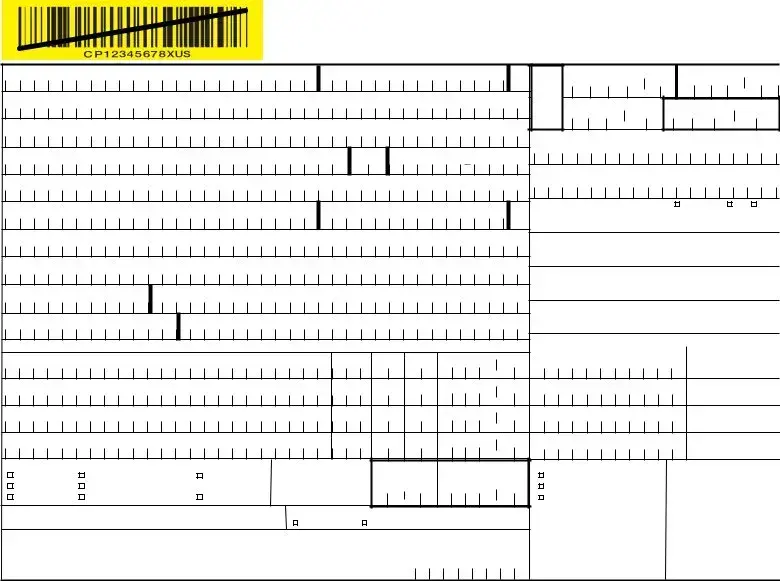
|
|
|
|
|
|
|
United States Postal Service® |
|
|
|
|
|
Customs Declaration and Dispatch Note |
— CP 72 |
|
|
|
IMPORTANT: This item may be opened officially. Please print in English, using blue or black ink, and press |
|
|
|
firmly; you are making multiple copies. See Privacy Notice and Indemnity Coverage on Sender’s Copy. |
FROM: Sender’s Last Name |
|
First |
|
|
MI |
Insured Amount (US $) |
SDR Value |
. |
Business |
|
|
|
|
|
|
$ |
0 |
0 |
|
|
|
|
|
|
|
. / |
/ |
|
|
|
|
|
|
|
Insurance Fees (US $) Total Postage/Fees (US $) |
Address (Number, street, suite, apt., P.O. Box, etc. Residents of Puerto Rico include Urbanization Code preceeded with URB.) |
$ |
. |
$ |
. |
|
|
|
|
|
|
|
13. Sender’s Customs Reference (If any) |
|
City |
|
|
State ZIP+4® |
|
|
|
|
|
|
Telephone/Fax or Email |
|
|
|
|
|
14. Importer’s Reference - Optional (If any) |
|
|
|
|
|
|
|
|
|
|
TO: Addressee’s Last Name |
|
First |
|
|
MI |
15. Importer’s Contact (select one) Telephone |
Fax Email |
Business |
|
|
|
|
|
|
16. icense No. |
|
|
|
|
|
|
|
|
|
|
|
|
|
Address (Number, street, suite, apt., P.O. Box, etc.) |
|
|
|
|
17. Certificate No. |
|
|
|
PostcodeS ACity |
|
|
|
|
E |
|
M P L18. Invoice No. |
|
State/Province |
Country |
|
|
|
|
|
|
|
|
1. Detailed Description of Contents (enter one item per line) |
2. Qty. |
3. Lbs. Oz. |
4. Value (U.S. $) |
|
For Commercial Senders Only |
|
|
19. HS Tariff Number |
|
20. Country of Origin |
|
|
|
|
|
. |
|
|
|
of Goods |
|
|
|
|
|
|
|
|
|
|
|
|
|
|
|
. |
|
|
|
|
|
|
|
|
|
|
. |
|
|
|
|
|
5. Check All That Apply: |
|
6. Other Restrictions: |
|
. |
|
9. If non-deliverable: |
|
Mailing Office Date Stamp |
Dangerous |
7. Total Gross |
8. Total Value US $ |
|
Gift |
Returned Goods |
(pertains to No. 11) |
Wt: (all items |
(all items) |
|
Treat as Abandoned |
|
|
Documents |
Commercial Sample |
Goods |
|
Lbs. & Ozs.) |
|
|
Return to Sender |
|
|
|
Merchandise |
Humanitarian Donation |
Other |
|
. |
. |
|
Redirect to Address Below |
|
|
10. AES/ITN/Exemption |
|
11. Restrictions: |
|
|
|
|
|
|
|
|
|
|
|
|
|
|
|
|
Quarantine |
Sanitary or Phytosanitary Inspection |
|
|
|
|
12.I certify the particulars given in this customs declaration are correct. This item does not contain any undeclared dangerous
articles, or articles prohibited by legislation or by postal or customs regulations. I have met all applicable export filing requirements
under federal law and regulations. Sender’s Signature and DateMonth Day Year
PS Form 2976-A, July 2013 PSN 7530-01-000-9834 |
Do not duplicate this form without USPS® approval. |
1 – Customs Declaration |
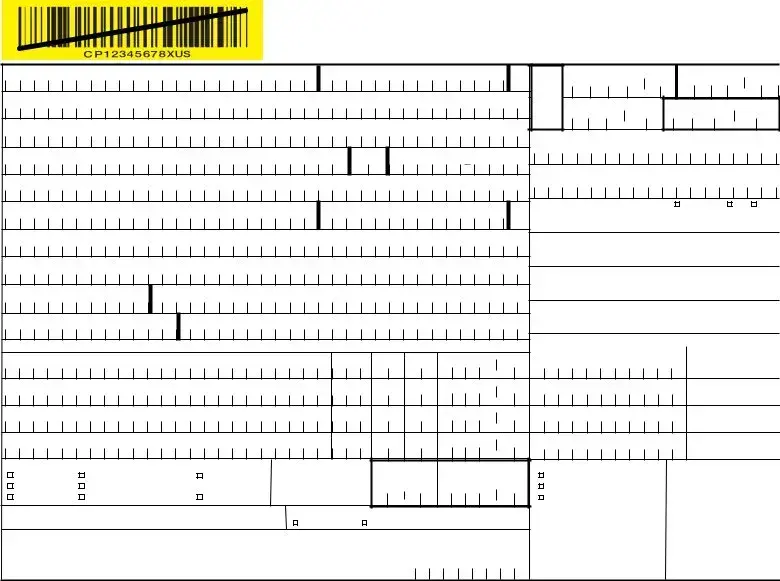
|
|
|
|
|
|
|
United States Postal Service® |
|
|
|
|
|
Customs Declaration and Dispatch Note |
— CP 72 |
|
|
|
IMPORTANT: This item may be opened officially. Please print in English, using blue or black ink, and press |
|
|
|
firmly; you are making multiple copies. See Privacy Notice and Indemnity Coverage on Sender’s Copy. |
FROM: Sender’s Last Name |
|
First |
|
|
MI |
Insured Amount (US $) |
SDR Value |
. |
Business |
|
|
|
|
|
|
$ |
0 |
0 |
|
|
|
|
|
|
|
. / |
/ |
|
|
|
|
|
|
|
Insurance Fees (US $) Total Postage/Fees (US $) |
Address (Number, street, suite, apt., P.O. Box, etc. Residents of Puerto Rico include Urbanization Code preceeded with URB.) |
$ |
. |
$ |
. |
|
|
|
|
|
|
|
13. Sender’s Customs Reference (If any) |
|
City |
|
|
State ZIP+4® |
|
|
|
|
|
|
Telephone/Fax or Email |
|
|
|
|
|
14. Importer’s Reference - Optional (If any) |
|
|
|
|
|
|
|
|
|
|
TO: Addressee’s Last Name |
|
First |
|
|
MI |
15. Importer’s Contact (select one) Telephone |
Fax Email |
Business |
|
|
|
|
|
|
16. icense No. |
|
|
|
|
|
|
|
|
|
|
|
|
|
Address (Number, street, suite, apt., P.O. Box, etc.) |
|
|
|
|
17. Certificate No. |
|
|
|
PostcodeS ACity |
|
|
|
|
E |
|
M P L18. Invoice No. |
|
State/Province |
Country |
|
|
|
|
|
|
|
|
1. Detailed Description of Contents (enter one item per line) |
2. Qty. |
3. Lbs. Oz. |
4. Value (U.S. $) |
|
For Commercial Senders Only |
|
|
19. HS Tariff Number |
|
20. Country of Origin |
|
|
|
|
|
. |
|
|
|
of Goods |
|
|
|
|
|
|
|
|
|
|
|
|
|
|
|
. |
|
|
|
|
|
|
|
|
|
|
. |
|
|
|
|
|
5. Check All That Apply: |
|
6. Other Restrictions: |
|
. |
|
9. If non-deliverable: |
|
Mailing Office Date Stamp |
Dangerous |
7. Total Gross |
8. Total Value US $ |
|
Gift |
Returned Goods |
(pertains to No. 11) |
Wt: (all items |
(all items) |
|
Treat as Abandoned |
|
|
Documents |
Commercial Sample |
Goods |
|
Lbs. & Ozs.) |
|
|
Return to Sender |
|
|
|
Merchandise |
Humanitarian Donation |
Other |
|
. |
. |
|
Redirect to Address Below |
|
|
10. AES/ITN/Exemption |
|
11. Restrictions: |
|
|
|
|
|
|
|
|
|
|
|
|
|
|
|
|
Quarantine |
Sanitary or Phytosanitary Inspection |
|
|
|
|
12.I certify the particulars given in this customs declaration are correct. This item does not contain any undeclared dangerous
articles, or articles prohibited by legislation or by postal or customs regulations. I have met all applicable export filing requirements
under federal law and regulations. Sender’s Signature and DateMonth Day Year
PS Form 2976-A, July 2013 PSN 7530-01-000-9834 |
Do not duplicate this form without USPS® approval. |
2 – Customs Declaration |

|
|
|
|
|
United States Postal Service® |
|
|
|
Customs Declaration and Dispatch Note |
— CP 72 |
|
|
IMPORTANT: This item may be opened officially. Please print in English, using blue or black ink, and press |
|
|
firmly; you are making multiple copies. See Privacy Notice and Indemnity Coverage on Sender’s Copy. |
FROM: Sender’s Last Name |
|
First |
|
MI |
Insured Amount (US $) |
|
SDR Value |
. |
Business |
|
|
|
|
$ |
0 |
0 |
|
|
|
|
|
|
. / |
/ |
|
|
|
|
|
|
Insurance Fees (US $) Total Postage/Fees (US $) |
Address (Number, street, suite, apt., P.O. Box, etc. Residents of Puerto Rico include Urbanization Code preceeded with URB.) |
$ |
. |
$ |
|
. |
|
|
|
|
|
13. Sender’s Customs Reference (If any) |
|
City |
|
State |
ZIP+4® |
|
|
|
|
|
|
Telephone/Fax or Email |
|
|
|
|
14. Importer’s Reference - Optional (If any) |
|
|
|
|
|
|
|
|
|
|
TO: Addressee’s Last Name |
|
First |
|
MI |
15. Importer’s Contact (select one) |
Telephone |
Fax Email |
Business |
|
|
|
|
Declaration by ADDRESS : I have received the parcel |
|
|
|
|
|
described on this note. ADDR SS |
’S Signature and Date |
Address (Number, street, suite, apt., P.O. Box, etc.) |
|
|
|
|
|
|
Month Day Year |
M P L18. Invoice No. |
E |
|
PostcodeS ACity |
|
State/Province |
Country |
|
|
|
|
|
|
|
|
Office of Exchange |
|
|
Customs Stamp |
|
Please affix labels here when required. |
|
|
|
|
|
|
|
|
|
|
|
|
|
|
|
|
|
Customs Duty |
|
|
|
|
|
|
|
|
|
|
|
|
|
|
|
|
|
5. Check All That Apply: |
Dangerous |
6. Other Restrictions: |
7. Total Gross |
8. Total Value US $ |
9. If non-deliverable: |
Mailing Office Date Stamp |
Gift |
Returned Goods |
(pertains to No. 11) |
Wt: (all items |
(all items) |
Treat as Abandoned |
|
Documents |
Commercial Sample |
Goods |
|
. |
|
. |
|
Return to Sender |
|
|
Lbs. & Ozs.) |
|
|
|
|
|
|
|
Merchandise |
Humanitarian Donation |
Other |
|
|
|
|
|
|
|
|
|
|
|
Redirect to Address Below |
|
|
|
|
|
|
|
|
|
|
|
|
|
|
|
|
|
10. AES/ITN/Exemption |
|
11. Restrictions: |
|
|
|
|
|
|
|
|
|
|
|
|
|
|
|
Quarantine |
Sanitary or Phytosanitary Inspection |
|
|
12.I certify the particulars given in this customs declaration are correct. This item does not contain any undeclared dangerous
articles, or articles prohibited by legislation or by postal or customs regulations. I have met all applicable export filing requirements
under federal law and regulations. Sender’s Signature and DateMonth Day Year
PS Form 2976-A, July 2013 PSN 7530-01-000-9834 |
Do not duplicate this form without USPS® approval. |
3 – Dispatch Note |
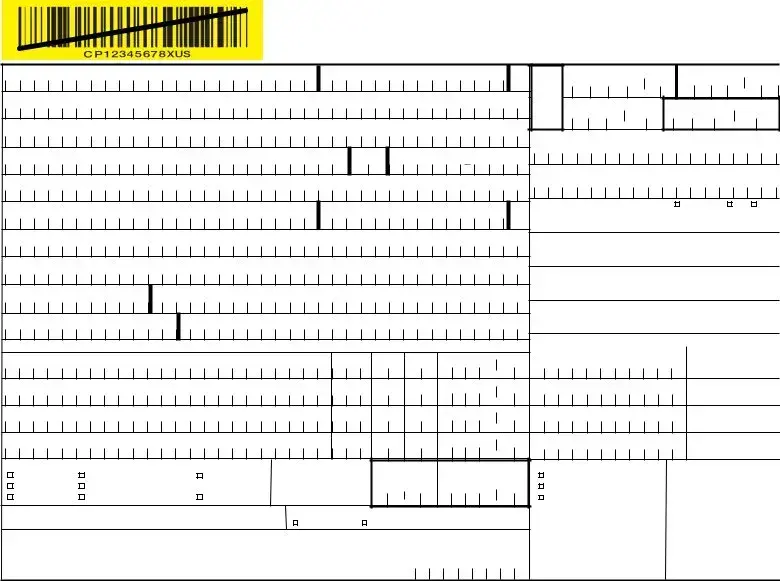
|
|
|
|
|
|
|
United States Postal Service® |
|
|
|
|
|
Customs Declaration and Dispatch Note |
— CP 72 |
|
|
|
IMPORTANT: This item may be opened officially. Please print in English, using blue or black ink, and press |
|
|
|
firmly; you are making multiple copies. See Privacy Notice and Indemnity Coverage on Sender’s Copy. |
FROM: Sender’s Last Name |
|
First |
|
|
MI |
Insured Amount (US $) |
SDR Value |
. |
Business |
|
|
|
|
|
|
$ |
0 |
0 |
|
|
|
|
|
|
|
. / |
/ |
|
|
|
|
|
|
|
Insurance Fees (US $) Total Postage/Fees (US $) |
Address (Number, street, suite, apt., P.O. Box, etc. Residents of Puerto Rico include Urbanization Code preceeded with URB.) |
$ |
. |
$ |
. |
|
|
|
|
|
|
|
13. Sender’s Customs Reference (If any) |
|
City |
|
|
State ZIP+4® |
|
|
|
|
|
|
Telephone/Fax or Email |
|
|
|
|
|
14. Importer’s Reference - Optional (If any) |
|
|
|
|
|
|
|
|
|
|
TO: Addressee’s Last Name |
|
First |
|
|
MI |
15. Importer’s Contact (select one) Telephone |
Fax Email |
Business |
|
|
|
|
|
|
16. icense No. |
|
|
|
|
|
|
|
|
|
|
|
|
|
Address (Number, street, suite, apt., P.O. Box, etc.) |
|
|
|
|
17. Certificate No. |
|
|
|
PostcodeS ACity |
|
|
|
|
E |
|
M P L18. Invoice No. |
|
State/Province |
Country |
|
|
|
|
|
|
|
|
1. Detailed Description of Contents (enter one item per line) |
2. Qty. |
3. Lbs. Oz. |
4. Value (U.S. $) |
|
For Commercial Senders Only |
|
|
19. HS Tariff Number |
|
20. Country of Origin |
|
|
|
|
|
. |
|
|
|
of Goods |
|
|
|
|
|
|
|
|
|
|
|
|
|
|
|
. |
|
|
|
|
|
|
|
|
|
|
. |
|
|
|
|
|
5. Check All That Apply: |
|
6. Other Restrictions: |
|
. |
|
9. If non-deliverable: |
|
Mailing Office Date Stamp |
Dangerous |
7. Total Gross |
8. Total Value US $ |
|
Gift |
Returned Goods |
(pertains to No. 11) |
Wt: (all items |
(all items) |
|
Treat as Abandoned |
|
|
Documents |
Commercial Sample |
Goods |
|
Lbs. & Ozs.) |
|
|
Return to Sender |
|
|
|
Merchandise |
Humanitarian Donation |
Other |
|
. |
. |
|
Redirect to Address Below |
|
|
10. AES/ITN/Exemption |
|
11. Restrictions: |
|
|
|
|
|
|
|
|
|
|
|
|
|
|
|
|
Quarantine |
Sanitary or Phytosanitary Inspection |
|
|
|
|
12.I certify the particulars given in this customs declaration are correct. This item does not contain any undeclared dangerous
articles, or articles prohibited by legislation or by postal or customs regulations. I have met all applicable export filing requirements
under federal law and regulations. Sender’s Signature and DateMonth Day Year
PS Form 2976-A, July 2013 PSN 7530-01-000-9834 |
Do not duplicate this form without USPS® approval. |
4 – Post Office Copy |
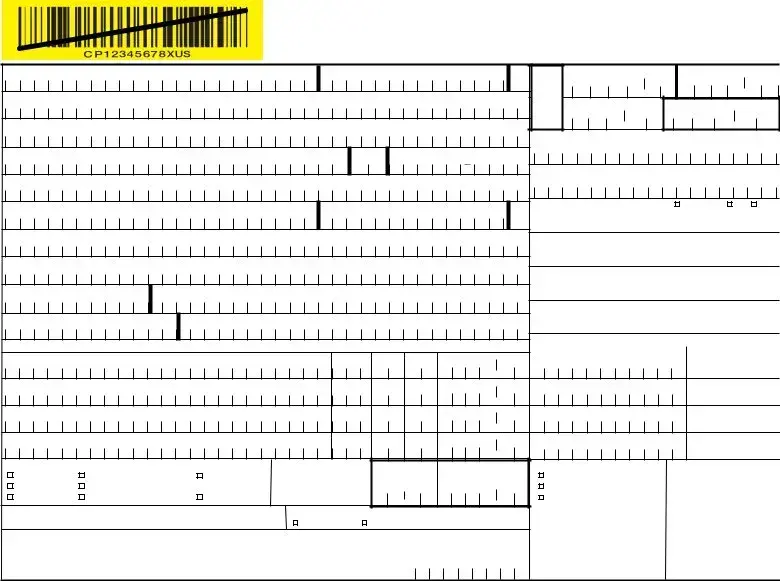
|
|
|
|
|
|
|
United States Postal Service® |
|
|
|
|
|
Customs Declaration and Dispatch Note |
— CP 72 |
|
|
|
IMPORTANT: This item may be opened officially. Please print in English, using blue or black ink, and press |
|
|
|
firmly; you are making multiple copies. See Privacy Notice and Indemnity Coverage on Sender’s Copy. |
FROM: Sender’s Last Name |
|
First |
|
|
MI |
Insured Amount (US $) |
SDR Value |
. |
Business |
|
|
|
|
|
|
$ |
0 |
0 |
|
|
|
|
|
|
|
. / |
/ |
|
|
|
|
|
|
|
Insurance Fees (US $) Total Postage/Fees (US $) |
Address (Number, street, suite, apt., P.O. Box, etc. Residents of Puerto Rico include Urbanization Code preceeded with URB.) |
$ |
. |
$ |
. |
|
|
|
|
|
|
|
13. Sender’s Customs Reference (If any) |
|
City |
|
|
State ZIP+4® |
|
|
|
|
|
|
Telephone/Fax or Email |
|
|
|
|
|
14. Importer’s Reference - Optional (If any) |
|
|
|
|
|
|
|
|
|
|
TO: Addressee’s Last Name |
|
First |
|
|
MI |
15. Importer’s Contact (select one) Telephone |
Fax Email |
Business |
|
|
|
|
|
|
16. icense No. |
|
|
|
|
|
|
|
|
|
|
|
|
|
Address (Number, street, suite, apt., P.O. Box, etc.) |
|
|
|
|
17. Certificate No. |
|
|
|
PostcodeS ACity |
|
|
|
|
E |
|
M P L18. Invoice No. |
|
State/Province |
Country |
|
|
|
|
|
|
|
|
1. Detailed Description of Contents (enter one item per line) |
2. Qty. |
3. Lbs. Oz. |
4. Value (U.S. $) |
|
For Commercial Senders Only |
|
|
19. HS Tariff Number |
|
20. Country of Origin |
|
|
|
|
|
. |
|
|
|
of Goods |
|
|
|
|
|
|
|
|
|
|
|
|
|
|
|
. |
|
|
|
|
|
|
|
|
|
|
. |
|
|
|
|
|
5. Check All That Apply: |
|
6. Other Restrictions: |
|
. |
|
9. If non-deliverable: |
|
Mailing Office Date Stamp |
Dangerous |
7. Total Gross |
8. Total Value US $ |
|
Gift |
Returned Goods |
(pertains to No. 11) |
Wt: (all items |
(all items) |
|
Treat as Abandoned |
|
|
Documents |
Commercial Sample |
Goods |
|
Lbs. & Ozs.) |
|
|
Return to Sender |
|
|
|
Merchandise |
Humanitarian Donation |
Other |
|
. |
. |
|
Redirect to Address Below |
|
|
10. AES/ITN/Exemption |
|
11. Restrictions: |
|
|
|
|
|
|
|
|
|
|
|
|
|
|
|
|
Quarantine |
Sanitary or Phytosanitary Inspection |
|
|
|
|
12.I certify the particulars given in this customs declaration are correct. This item does not contain any undeclared dangerous
articles, or articles prohibited by legislation or by postal or customs regulations. I have met all applicable export filing requirements
under federal law and regulations. Sender’s Signature and DateMonth Day Year
PS Form 2976-A, July 2013 PSN 7530-01-000-9834 |
Do not duplicate this form without USPS® approval. |
5 – Sender’s Copy |

IMPORTANT: Save this receipt and present it when making an inquiry.
PARCEL INDEMNITY COVERAGE: Indemnity for Priority Mail International® parcels, including insured and ordinary (uninsured) parcels, is provided only in accordance with Postal Service™ regulations in the Domestic Mail Manual (DMM®) and the International Mail Manual (IMM®). The DMM and IMM are available online at http://pe.usps.com. The addressee must report damage or missing contents to the delivering Post Office™ immediately.
Ordinary (uninsured) Priority Mail International parcels include indemnity coverage against loss, damage, or missing contents. Indemnity is limited to the lesser of the actual value of the contents or the maximum indemnity based on the weight of the article. Priority Mail International Flat Rate Envelopes and Priority Mail International Small Flat Rate Boxes are letter-post items and do not include indemnity coverage.
Insured mail service is available for a fee and replaces indemnity on ordinary parcels. Insurance coverage varies by country and is not availableSto some countries. AIndemnity coverage isMsubject to both U.S. PostalPService® regulationsLand the domestic Eregulations of the destination country. Insurance for loss, damage, or missing contents covers the actual (depreciated) value of the contents.
Claims for lost ordinary and insured parcels may be payable only to the sender, and claims for damage and missing contents may be payable only to the addressee. The sender or addressee may waive the right of payment in favor of the other.
FILING CLAIM : To initiate an inquiry for loss, damage, or missing contents, call the International Inquiry Center at 800-222-1811. International indemnity inquiries and claims for loss must be filed within the time limits for the service purchased. All claims for damage or missing contents must be filed immediately, and the article, containers, packaging, and all contents received must be presented to the destination Post Office.
Evidence of mailing (e.g., original mailing receipts or wrapper), evidence of insurance, and evidence of value (e.g., sales receipt or repair estimate) must be submitted in support of all claims. For complete regulations, see the IMM at http://pe.usps.com.
EXCEPTIONS: No coverage is provided for consequential losses, delay, concealed damage, spoilage of perishable items, articles improperly packaged, articles too fragile to withstand normal handling in the mails, or prohibited articles. See the DMM and the IMM for the specific types of losses that are covered, the limitations on coverage, the terms of insurance or indemnity, and the conditions of payment.
IMPORTANT: Indemnity coverage is not paid for Priority Mail Express International™ or ordinary (uninsured) Priority Mail International parcels
containing the following: coins; banknotes; currency notes, including paper money; securities of any kind payable to the bearer; traveler’s checks; platinum, gold, and silver; precious stones; jewelry; watches; and other valuable or prohibited articles. See the IMM for complete regulations.
PRIVACY ACT STATEMENT: Your information will be used to satisfy reporting requirements for customs purposes. Collection is authorized by
39 U.S.C. 401, 403, 404, and 407; 13 U.S.C. 301–307; and 50 U.S.C. 1702. Providing the information is voluntary, but if not provided, we may not process your transaction. We do not disclose your information to third parties without your consent, except to facilitate the transaction, to act on your behalf or request, or as legally required. This includes the following limited circumstances: to a congressional office on your behalf; to financial entities regarding financial transaction issues; to a U.S. Postal Service auditor; to entities, including law enforcement, as required by law or in legal proceedings; to contractors and other entities aiding us to fulfill the service (service providers); to domestic and international customs pursuant to federal law and agreements; and to other governmental entities with authority over exportation. For more information regarding our privacy policies, visit usps.com/privacypolicy.
PS Form 2976-A, July 2013 PSN 7530-01-000-9834 |
Reverse of Page 5 of 5, Sender’s Copy |
